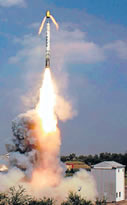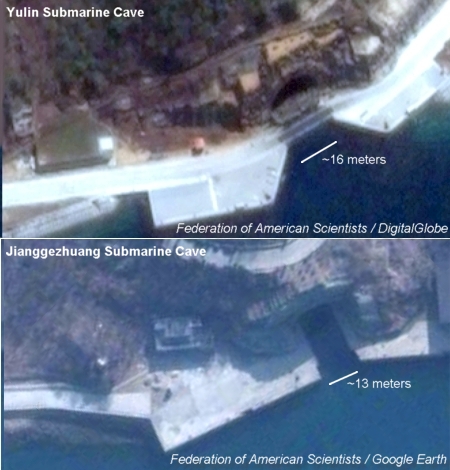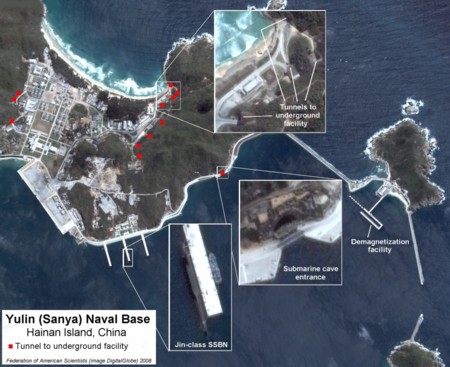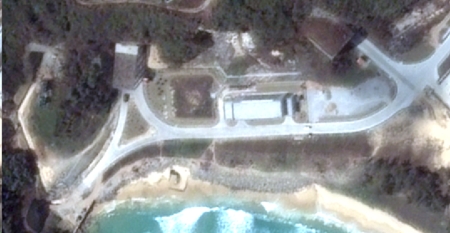India’s Nuclear Forces 2008
  |
| Mystery missile: widely reported as a future sea-launched ballistic missile, is the Shourya launch in November 2008 (right) a land-based mobile missile (left), a silo-based missile, or a hybrid? Images: DRDO |
.
By Hans M. Kristensen
A decade after India officially crossed the nuclear threshold and announced its intention to develop a Triad of nuclear forces based on land-, air-, and sea-based weapon systems, its operational force primarily consists of gravity bombs delivered by fighter jets. Short of the short-range Prithvi, longer-range Agni ballistic missiles have been hampered by technical problems limiting their full operational status [Update Feb. 2, 2009: “Defense sources” quoted by Times of India appear to confirm that the Agni missiles are not yet fully operational]. A true sea-based deterrent capability is still many years away.
Despite these constraints, indications are that India’s nuclear capabilities may evolve significantly in the next decade as Agni II and Agni III become operational, the long-delayed ATV nuclear-powered ballistic missile submarine is delivered, and warhead production continues for these and other new systems.
Our latest estimate of India’s nuclear forces is available from the Bulletin of the Atomic Scientists.
New Chinese SSBN Deploys to Hainan Island
By Hans M. Kristensen
The Chinese navy has deployed a Jin-class (Type 094) ballistic missile submarine to a new base near Yulin on Hainan Island on the South China Sea, according to a satellite image obtained by FAS. The image shows the submarine moored at a pier close to a large sea-entrance to an underground facility.
Also visible is a unique newly constructed pier that appears to be a demagnetization facility for submarines.
A dozen tunnels to underground facilities are visible throughout the base compound.
The satellite image, which has also been described in Jane’s Defense Weekly, was taken by the QuickBird satellite on February 27, 2008, and purchased by FAS from DigitalGlobe.
The Arrival of the Jin-Class Submarine
The dimensions of the submarine in the satellite image are similar to the Jin-class SSBN I spotted at Xiaopingdao Submarine Base in July 2007 and the two Jin-class SSBNs I detected at the Bohai shipyard in October 2007.
China is believed to have launched two Jin-class SSBNs with a third possibly under construction. The U.S. Intelligence community estimates that China might possibly build five SSBNs if it wants to have a near-continuous deterrent at sea. Of course, it is not known whether China plans to operate its SSBNs that way. See Figure 1 for the location of the submarine.
.
Missile loadout of the SSBN will probably take place at pierside at the main pier to the left of the narrow triple-pier where the submarine is seen, unless the underground facility is large enough to permit such operations out of satellite view. Not yet visible at the base is a dry dock large enough to accommodate an SSBN; the Northern Fleet submarine base at Jianggezhuang has a dry dock.
New Demagnetization Facility
One of the most interesting new additions to the base is what appears to be a submarine demagnetization facility (see Figure 2). Located in the southern part of the base and connected by pier to a facility on a small island, the demagnetization facility closely resembles such facilities at U.S. SSBN bases. Demagnetization is conducted before deployment to remove residual magnetic fields in the metal of the submarine to make it harder to detect by other submarines and surface ships. There is no demagnetization facility at the Jianggezhuang base, so this appears to be a new capability for China.
|
Figure 2: |
 |
| Since 2005, what appears to be a submarine demagnetization facility has been added to the base. Click on image for larger photo. |
.
Underground Facilities
The base has extensive underground facilities. The most obvious is a large portal over a sea-entrance to what is probably an underground facility. The entrance appears to be approximately 3 meters (15 feet) wider than a similar entrance at the Northern Fleet Jianggezhuang Naval Base (see Figure 3 for comparison).
|
Figure 3: |
 |
| The submarine cave entrance at Yulin Naval Base (top) is approximately 3 meters wider than the one at Jianggezhuang Naval Base. Click on image for larger photo of the Yulin entrance. Description of the Jianggezhuang facility is available here. |
.
Although the interior of the facility is not known, it probably includes a canal at least the length of one submarine as well as halls for handling or possibly storing equipment as well as rooms for personnel. Directly on the other side of the mountain are several land-entrances that might connect to the central facility as well, although none of this is known for sure. Two of those entrances appear from their shadows to be very tall structures (see Figure 4).
.
Some Implications
The SSBN base on Hainan Island will probably be seen as a reaffirmation of China’s ambitions to develop a sea-based deterrent. To what extent the Chinese navy will be capable of operating the SSBNs in a way that matters strategically is another question. China’s first SSBN, the Xia, was no success and never sailed on a deterrent mission. As a consequence, the Chinese navy has virtually no tactical experience in operating SSBNs at sea. Yet the Jin-class and the demagnetization facility on Hainan Island show they’re trying.
The location of the base is important because the Indian government already has pointed to a future threat from Chinese missile submarines operating in the South China Sea or Indian Ocean. The arrival of the Jin-class in Hainan will probably help sustain India’s own SSBN program. For China to sail an SSBN into the India Ocean and operate it there in a meaningful way, however, will be very difficult and dangerous in a crisis. Chinese SSBNs are more likely to stay close to home.
The base on Hainan Island is near deep water and some analysts suggest this will support submarine patrols better that operations from the Northern Fleet base at Jianggezhuang. Of course, if the water is so shallow the submarine can’t submerge fully it will limit operations, but deep water is – contrary to popular perception – not necessarily an advantage. Military submarines generally are not designed to dive deeper than 400-600 meters, so great ocean depth may be of little value. The U.S. navy has several decades of experience in trailing Soviet SSBNs in the open oceans; shallow waters are much more challenging. And the South China Sea is a busy area for U.S. attack submarines, which have unconstrained access to the waters off Hainan Island. And I’d be surprised if there were not a U.S. “shadow” following the Jin-class SSBN when it arrived at Hainan Island.
Additional information: Chinese Nuclear Forces and U.S. Nuclear War Planning | Chinese Submarine Patrols Rebound in 2007, but Remain Limited | A Closer Look at China’s New SSBNs
Congressman Markey on the US-India Nuclear Deal
Last week, Congressman Ed Markey (D-Mass) visited FAS to talk about the India-US deal. Markey, who strongly supports closer ties with India, opposes the nuclear deal because it undermines the Non-proliferation Treaty (NPT). A transcript and video of his comments are on the FAS website.
What I found most interesting about his talk was a graphic showing the growth in U.S.-Indian trade over the past few decades. (Our chart is not a reproduction of the chart used my Mr. Markey but created from the same data.) It goes up…and up and up. It has gone up even during politically difficult times, for example, after the 1974 Indian nuclear test. The Congressman’s point is that, when people argue for the nuclear deal because it will allow a blossoming of trade between the two countries, they miss the point entirely. Trade with India has been growing for years, it continues to grow now, and it will grow in the future whether we have a nuclear deal or not. So the trade benefit is simply not there. But the harm done to the NPT definitely remains.
(more…)
Through the Indian Looking Glass
In an earlier blog (see below), I discussed how, during the Congressional debate about the US-India nuclear deal, even those members of Congress opposed to the deal bent over backwards to declare their support for closer ties between the world’s two largest democracies. And everyone agreed the deal is generous, opens long-closed doors, and sets minimal and perfectly reasonable expectations of India.
So what are we to make of the brouhaha in New Delhi? According to reports in both the Indian and western press, the US-Indian nuclear deal is being denounced, mostly by the communist and allied parties, as an unacceptable constraint on Indian sovereignty. (I want to thank Leonor Tomero for her extremely helpful India news summary.)
(more…)
India Gets a Deal
The much anticipated “deal” between the United States and India for the transfer of nuclear technology and equipment was released over the weekend. It is a sobering read and tells us much about the administration’s thinking. In summary, there isn’t much of a deal here at all, India gets what it wants.
(more…)
Nuclear Missile Testing Galore
 (Updated January 3, 2007)
(Updated January 3, 2007)
North Korea may have gotten all the attention, but all the nuclear weapon states were busy flight-testing ballistic missiles for their nuclear weapons during 2006. According to a preliminary count, eight countries launched more than 28 ballistic missiles of 23 types in 26 different events.
Unlike the failed North Korean Taepo Dong 2 launch, most other ballistic missile tests were successful. Russia and India also experienced missile failures, but the United States demonstrated a very reliable capability including the 117th consecutive successful launch of the Trident II D5 sea-launched ballistic missile.
The busy ballistic missile flight testing represents yet another double standard in international security, and suggests that initiatives are needed to limit not only proliferating countries from developing ballistic missiles but also find ways to curtail the programs of the existing nuclear powers.
The ballistic missile flight tests involved weapons ranging from 10-warhead intercontinental ballistic missiles down to single-warhead short-range ballistic missiles. Most of the flight tests, however, involved long-range ballistic missiles and the United States, Russia and France also launched sea-launched ballistic missiles (see table below).
|
Ballistic Missile Tests |
||
| Date | Missile | Remarks |
| China | ||
| 5 Sep | 1 DF-31 ICBM |
From Wuzhai, impact in Takla Makan Desert. |
| France | ||
| 9 Nov | 1 M51 SLBM | From Biscarosse (CELM facility), impact in South Atlantic. |
| India | ||
| 13 Jun | 1 Prithvi I SRBM |
From Chandipur, impact in Indian Ocean. |
| 9 Jul | 1 Agni III IRBM |
From Chandipur. Failed. |
| 20 Nov | 1 Prithvi I SRBM |
From Chandipur, impact in Indian Ocean. |
| Iran** | ||
| 23 May | 1 Shahab 3D MRBM |
From Emamshahr. |
| 3 Nov | 1 Shahab 3 MRBM, as well as “dozens” of Shahab 2, Scud B and other SRBMs |
Part of the Great Prophet 2 exercise. |
| North Korea*** | ||
| 4 Jul | 1 Taepo Dong 2 ICBM and 6 Scud C and Rodong SRBMs |
From Musudan-ri near Kalmo. ICBM failed. |
| Pakistan | ||
| 16 Nov | 1 Ghauri MRBM |
From Tilla? |
| 29 Nov | 1 Hatf-4 (Shaheen-I) SRBM |
Part of Strategic Missile Group exercise. |
| 9 Dec | 1 Haft-3 (Ghaznavi) SRBM |
Part of Strategic Missile Group exercise. |
| Russia | ||
| 28 Jul | 1 SS-18 ICBM | Attempt to launch satellite, but technically an SS-18 flight test (see comments below). |
| 3 Aug | 1 Topol (SS-25) ICBM |
From Plesetsk, impact on Kura range. |
| 7 Sep | 1 Bulava SLBM |
From Dmitry Donskoy (Typhoon) in White Sea. Failed. |
| 9 Sep | 1 SS-N-23 SLBM |
From K-84 (Delta IV) at North Pole, impact on Kizha range. |
| 10 Sep | 1 SS-N-18 SLBM |
From Delta III in Pacific, impact on Kizha range. |
| 25 Oct | 1 Bulava SLBM |
From Dmitry Donskoy (Typhoon) in White Sea. Failed. |
| 9 Nov | 1 SS-19 ICBM |
From Silo in Baykonur, impact on Kura range. |
| 21 Dec | 1 SS-18 ICBM |
From Orenburg, impact on Kura range. |
| 24 Dec | 1 Bulava SLBM |
From White Sea. Third stage failed. |
| United States | ||
| 16 Feb | 1 Minuteman III ICBM |
From Vandenberg AFB, impact Kwajalein. Final W87/Mk-21 SERV test flight. |
| Mar/Apr | 2 Trident II D5 SLBMs |
From SSBN. |
| 4 Apr | 1 Minuteman III ICBM |
From Vandenberg AFB, impact near Guam. Extended-range, single-warhead flight test. |
| 14 Jun | 1 Minuteman III ICBM |
From Vandenberg AFB, impact Kwajalein. Three-warhead payload. |
| 20 Jul | 1 Minuteman III ICBM |
From Vandenberg AFB, impact Kwajalein. Three-warhead flight test. Launched by E-6B TACAMO airborne command post. |
| 21 Nov | 2 Trident II D5 SLBMs |
From USS Maryland (SSBN-738) off Florida, impact in South Atlantic. |
| * Unreported events may add to the list. ** Iran does not have nuclear weapons but is suspected of pursuing nuclear weapons capability. *** It is unknown if North Korea has developed a nuclear reentry vehicle for its ballistic missiles. |
||
The Putin government’s reaffirmation of the importance of strategic nuclear forces to Russian national security was tainted by the failure of three consecutive launches of the new Bulava missile, but tests of five other missile types shows that Russia still has effective missile forces.
Along with China, Russia’s efforts continue to have an important influence on U.S. nuclear planning, and the eight Minuteman III and Trident II missiles launched in 2006 were intended to ensure a nuclear capability second to none. The first ICBM flight-test signaled the start of the deployment of the W87 warhead on the Minuteman III force.
China’s launch of the (very) long-awaited DF-31 ICBM and India’s attempts to test launch the Agni III raised new concerns because of the role the weapons likely will play in the two countries’ targeting of each other. But during a visit to India in June 2006, U.S. Chairman of the Joint Chiefs of Staff, General Peter Pace, downplayed at least the Indian issue saying other countries in the region also have tested missiles. In a statement that North Korea would probably find useful to use, Gen. Pace explained that “the fact that a country is testing something like a missile is not destabilizing” as long as it is “designed for defense, and then are intended for use for defense, and they have competence in their ability to use those weapons for defense, it is a stabilizing event.”
But since all “defensive” ballistic missiles have very offensive capabilities, and since no nation plans it defense based on intentions and statements anyway but on the offensive capabilities of potential adversaries, Gen. Pace’s explanation seemed disingenuous and out of sync with the warnings about North Korean, Iranian and Chinese ballistic missile developments.
The Missile Technology Control Regime (MTCR) seeks to limit the proliferation of ballistic missiles, but that vision seems undercut by the busy ballistic missile launch schedule demonstrated by the nuclear weapon states in 2006. Some MTCR member countries have launched the International Code of Conduct Against Ballistic Missile Proliferation initiative in an attempt to establish a norm against ballistic missiles, and have called on all countries to show greater restraint in their own development of ballistic missiles capable of delivering weapons of mass destruction and to reduce their existing missile arsenals if possible.
All the nuclear weapons states portray their own nuclear ballistic missile developments as stabalizing and fully in compliance with their pledge under the Non-Proliferation Treaty to pursue nuclear disarmament in good faith. But fast-flying ballistic missiles are inherently destablizing because of their vulnerability to attack may trigger use early on in a conflict. And the busy missile testing in 2006 suggests that the “good faith” is wearing a little thin.
President Signs US-India Nuclear Cooperation Agreement
On Monday, President Bush signed into law the Henry J. Hyde United States and India Nuclear Cooperation Promotion Act of 2006. The Federation of American Scientists strongly supports better ties—economic, cultural, technical, even security ties—with India. Specifically with energy production, there are many ways in which U.S. know-how could help India and the technology flow is not all one way, for example, India is, along with the United States, one of the world’s leaders in wind energy. But India made tacit acceptance of their nuclear weapons program the price of better relations. The Federation strongly opposed the nuclear deal because of the proliferation implications. We organized petitions to Congress. Thirty seven Nobel Prize winners from our Board of Sponsors signed a letter to the Congressional leadership opposing the agreement. We had a press conference where Michael Krepon and Len Weiss argued against the agreement and we released the Nobelist letter. In the end, however, the president and the Congress seem to have accepted the price set by India and here we are.
(more…)
Perspective on the Debate on the US-India Nuclear Deal.
Last week the House of Representatives debated and passed the United States and India Nuclear Cooperation Promotion Act of 2006. I think that most of the debate missed what I consider the most important points.
First of all, I should emphasize that every Congressman, even those most strongly opposed to the deal, introduced their remarks with praise for India. I have not yet come across any American commentator anywhere who does not feel that it is natural and desirable for the United States and India to have closer ties. I think that one of the great tragedies of the Cold War was that the United States and India seemed early on to have got their wires crossed because of misjudgments on both sides. The one issue on which everyone seems to agree is that India and the United States should be friends. Some of the Congressional comments in fact went a bit overboard. Congressman Davis of Illinois said, “India is a flourishing democracy that seeks to develop its nuclear program for purely peaceful reasons,” which is, of course, patently false—the purely peaceful part—but never mind, it fit the tone of the debate.
(more…)
House Overwhelmingly Approves Path to Nuclear Cooperation with India.
On Wednesday, the House of Representatives passed overwhelming, 359 to 68, a bill that sets out procedures for nuclear trade with India (the link includes the House floor debate and the text of the bill, about a third of way down). It is an entirely different bill than that proposed by the White House. The White House’s suggested bill was an insult to Congress, essentially asking Congress to cede any review rights and to approve details of the nuclear deal that haven’t even been decided yet. Whatever members of Congress thought about the India-US nuclear deal, they were not going to just leave the rubber stamp on the White House steps. The House bill, H.R. 5682, clearly rebukes the President on his request for pre-approval. The ultimate details of any agreement will have to go back to Congress for approval by joint resolution.
(more…)
Legislative Update on Indian-US Nuclear Deal
There have been some legislative developments on the India-US nuclear deal. The results are not what I would like to have seen but I suppose it could have been worse. On 27 June, the House International Relations Committee approved their version of the bill 37 to 5. On 29 June the Senate Foreign Relations Committee voted 16 to 2 in favor of their bill. Both bills give the administration and the Indians essentially everything they asked for except preapproval.
(more…)
IAEA Secretary General elBaradei Supports Indian-US Nuclear Deal.
In an op-ed in last Wednesday’s Washington Post, IAEA Secretary General Mohammad elBaradei endorsed the US-India nuclear deal without reservation. The Secretary makes several good points but he fails to demonstrate his assertion that the deal will help reach his own objectives.
(more…)
37 Nobel Laureates Sign Letter Opposing the Indian-US Nuclear Deal
Thirty seven Nobel Laureates signed a letter opposing the administration’s proposed nuclear trade deal between India and the United States. The letter was released at a press briefing at the National Press Club yesterday.
The Federation of American Scientists was founded by scientists who had worked on the Manhattan Project to develop the first atomic bombs. The founders of FAS understood that the technology that made nuclear power possible and the technology that made nuclear weapons possible were inextricably entangled. One of the founding issues of the Federation was, therefore, openness and international inspection, if not control, of all the world’s nuclear facilities. They recognized that this was the only hope of avoiding wide-spread proliferation of nuclear weapons.
Here we are sixty years later and faced with the same issue. The Federation strongly supports improved economic, cultural, trade, academic, and security relations with India. We would like to see Chinese, as well as US, Russian, indeed, everyone’s nuclear arsenals dramatically reduced and eventually eliminated. The Indian-US nuclear deal further undermines the already weakened non-proliferation regime and pushes the world in the wrong direction, toward greater legitimacy of nuclear weapons.
The Federation of American Scientists is proud that thirty seven Nobel Laureates on its Board of Sponsors agreed to endorse this letter to Congress.


